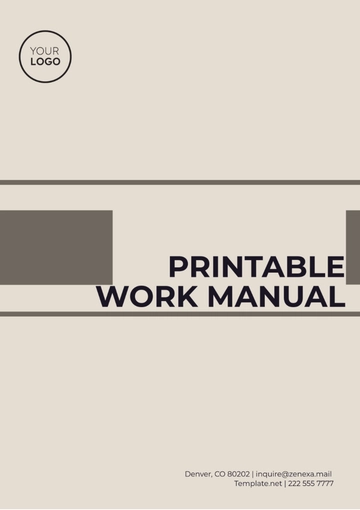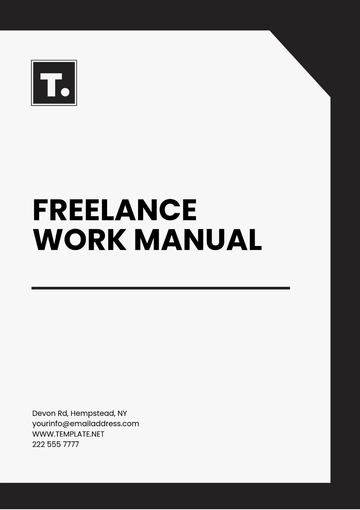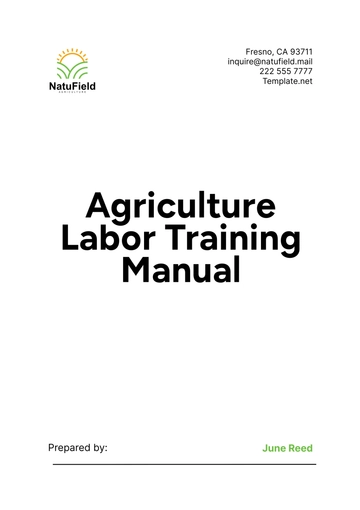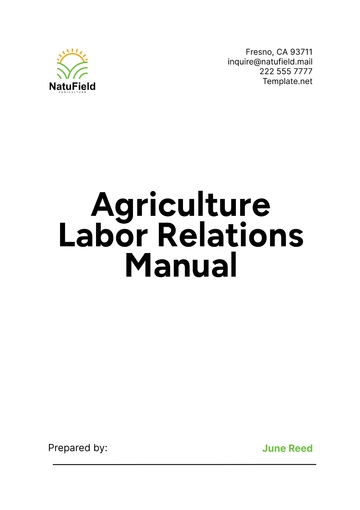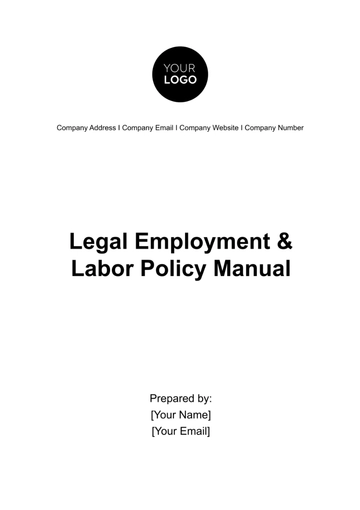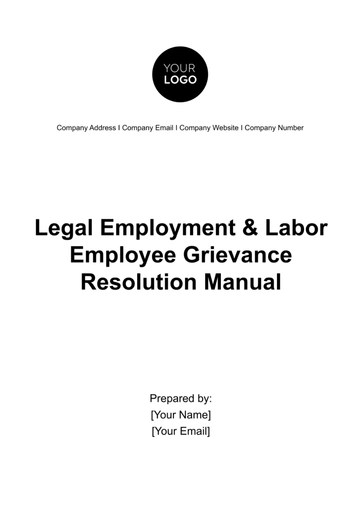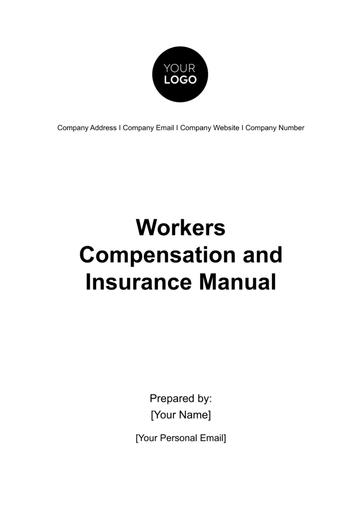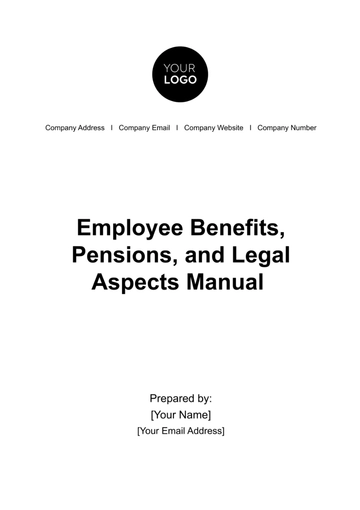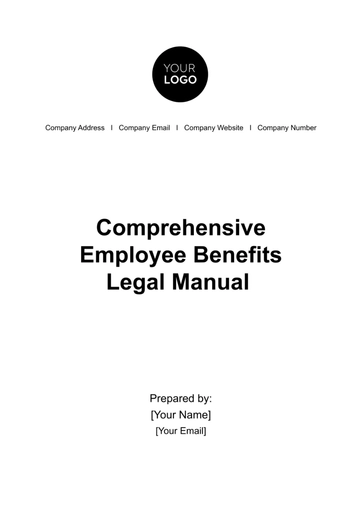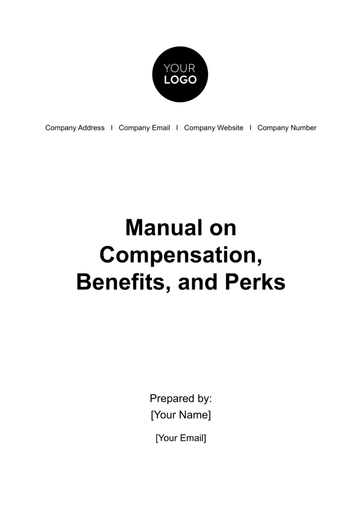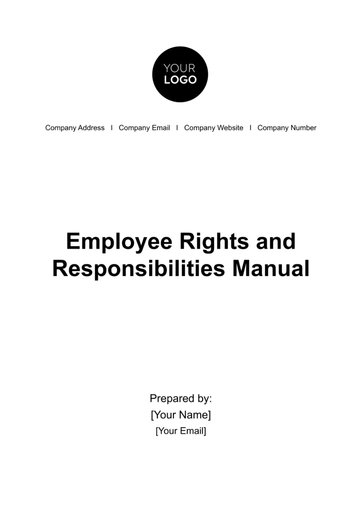Free Workers Compensation and Insurance Manual HR
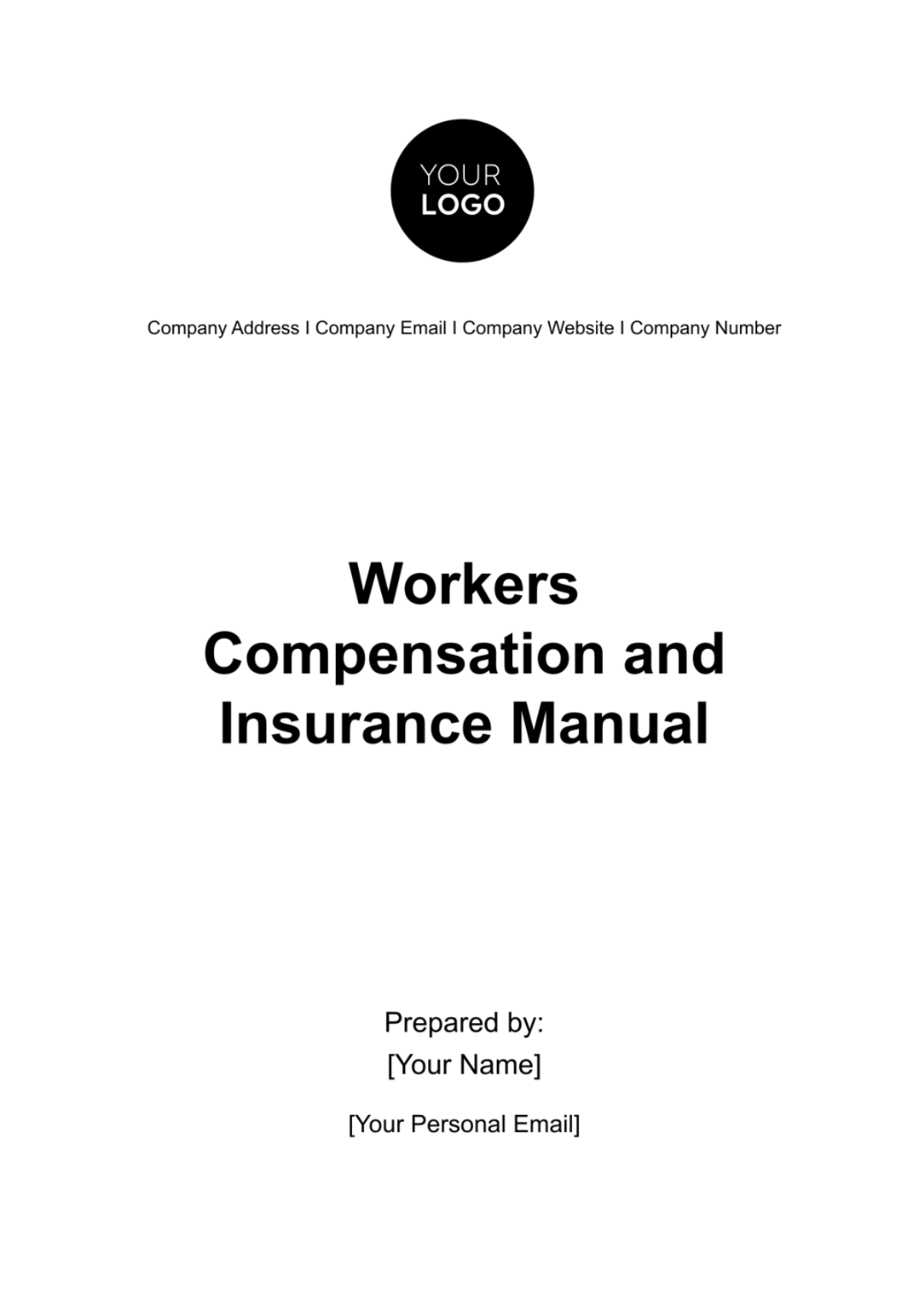
Published by: [Your Company Name]
For any inquiries, please contact: [Your Company Email] or at [Your Company Email]
Table of Contents
1. Introduction
2. Understanding Workers' Compensation
3. Insurance Coverage
4. Roles and Responsibilities
5. Claims Process
Return-to-Work Programs
Safety and Injury Prevention
Legal and Regulatory Compliance
Dispute Resolution
Employee Communication
Supervisor Training
Managing Premium Costs
Independent Contractors and Subcontractors
Emergencies and Crisis Management
1. Introduction
Welcome to the Workers' Compensation and Insurance Manual. This manual is designed to provide a comprehensive resource for businesses of all sizes and industries, outlining the essential aspects of workers' compensation in the United States.
Purpose and Scope of the Manual
This manual aims to educate employers, HR professionals, and employees on workers' compensation policies and procedures. It serves as a valuable reference for understanding how to navigate the complexities of this vital aspect of employee benefits.
Importance of Workers' Compensation
Workers' compensation is crucial for safeguarding employees' well-being in case of workplace injuries or illnesses. It helps provide medical care, financial support, and a path to recovery for injured workers.
Legal Framework and Compliance
The manual emphasizes the legal requirements and regulatory compliance associated with workers' compensation, ensuring that businesses adhere to HR standards and maintain lawful operations.
2. Understanding Workers' Compensation
Definition and Objectives
Workers' compensation is a legally mandated insurance program designed to provide financial assistance and medical benefits to employees who sustain work-related injuries or illnesses. Its primary objectives are:
To ensure injured employees receive necessary medical treatment.
To replace lost wages during the period of disability.
To facilitate the employee's return to work as soon as possible.
To protect employers from direct legal actions by injured employees.
Eligibility Criteria
To be eligible for workers' compensation benefits, employees generally must meet the following criteria:
Employment Status: The injury or illness must occur in the course of employment.
Notification: The employee must promptly report the injury or illness to their employer.
Filing Deadline: There are specific time limits for filing a workers' compensation claim.
Causation: The injury or illness must be work-related, meaning it occurred due to job duties.
Covered Employees and Exemptions
Workers' compensation typically covers most employees, but exemptions may apply, such as:
Independent Contractors
Agricultural Workers
Domestic Workers
Small Businesses
3. Insurance Coverage
In this section, we explore the intricacies of workers' compensation insurance coverage, from obtaining the necessary insurance to understanding premium calculations and policy terms.
Obtaining Workers' Compensation Insurance
To secure workers' compensation insurance, employers typically follow these steps:
Contact Insurance Providers ⬇ Assessment of Needs ⬇ Application Process ⬇ Underwriting ⬇ Policy Issuance |
Insurance Premium Calculation
Workers' compensation premiums are calculated based on various factors, including:
Industry Classification: Different industries have different levels of risk, affecting premiums.
Payroll: Your total annual payroll is a significant factor in premium calculation.
Experience Modification Factor: This factor considers your claims history and safety record.
State Regulations: Each state has its own rules and rates for workers' compensation insurance.
Employers can take steps to manage premium costs, such as implementing safety programs and reducing workplace hazards.
Policy Terms and Renewals
Workers' compensation policies typically have one-year terms. Key considerations for policy terms and renewals include:
Policy Expiration
Premium Adjustments
Policy Review
4. Roles and Responsibilities
This section outlines the key roles and responsibilities of various stakeholders involved in the workers' compensation process, including employers, employees, HR departments, and insurance providers.
Stakeholder | Responsibilities |
Employer |
|
Employee |
|
HR Department |
|
Insurance Provider |
|
5. Claims Process
Efficiently managing the claims process is vital to provide timely support to injured employees. This section outlines the essential steps in handling workers' compensation claims.
Reporting Workplace Injuries/Illnesses
Prompt Reporting: Injured employees must immediately report workplace injuries or illnesses to their supervisor or HR department.
Incident Documentation: Employers should document the incident's details, including date, time, location, and witnesses.
Filing a Workers' Compensation Claim
Completion of Forms: The injured employee or their representative completes the necessary workers' compensation claim forms.
Employer's Role: Employers assist employees in filing claims and promptly forward them to the insurance provider.
Medical Evaluation and Treatment
Medical Care: Injured employees receive necessary medical treatment from authorized healthcare providers.
Medical Records: Healthcare providers maintain detailed records of treatment and share them with the insurance provider.
Temporary and Permanent Disability Benefits
Temporary Disability: Eligible employees receive compensation to replace lost wages during their recovery period.
Permanent Disability: If a worker sustains a permanent impairment, they may receive ongoing disability benefits.
6. Return-to-Work Programs
A well-structured return-to-work program is integral to helping injured employees transition back into the workforce smoothly. This section explains the purpose and benefits of such programs, along with how to develop and implement them, including accommodations and transitional duties.
Purpose
Return-to-work programs aim to facilitate the safe and timely return of injured employees to their jobs, promoting their physical and financial well-being.
Benefits
Faster Recovery: Employees tend to recover more quickly when they remain engaged in the workplace.
Cost Savings: Reduced workers' compensation costs and potential litigation.
Employee Morale: Boosts employee morale and job satisfaction.
Skill Retention: Helps employees retain job skills and experience.
Compliance: Ensures compliance with workers' compensation laws and regulations.
Development and Implementation
HR departments collaborate with management, supervisors, and healthcare professionals to design return-to-work programs tailored to the company's needs.
Elements may include modified job duties, reduced work hours, temporary assignments, and access to necessary accommodations.
Clear communication with injured employees about the program's objectives, expectations, and available resources is crucial.
Regularly assess the effectiveness of the program and make necessary adjustments.
Accommodations and Transitional Duties
Employers should provide reasonable accommodations to help injured employees perform their job duties effectively. This may involve modifying workstations, providing assistive devices, or adjusting work hours.
If an employee cannot perform their regular job, transitional duties should be assigned that align with their current capabilities. These tasks should be meaningful and contribute to their rehabilitation.
7. Safety and Injury Prevention
Safety and injury prevention are paramount in maintaining a healthy and productive workforce. Fostering a workplace culture that prioritizes safety is crucial. This begins with leadership commitment to safety principles, encouraging employees at all levels to actively participate in safety initiatives and report concerns. Clearly communicated safety policies and the establishment of safety committees for regular assessments play pivotal roles in cultivating this culture. Additionally, conducting routine workplace inspections, encouraging hazard reporting, and implementing corrective actions are part of this process.
8. Legal and Regulatory Compliance
This section highlights the significance of understanding and complying with relevant laws, emphasizing record-keeping and documentation practices, and detailing posting requirements.
Federal and State Laws and Regulations
Employers must be well-versed in both federal and state-specific workers' compensation laws and regulations.
Federal regulations, such as those outlined by OSHA (Occupational Safety and Health Administration), set safety standards that must be followed.
State laws may vary, so it is essential to know the specific requirements for the location in which the business operates.
Record-Keeping and Documentation
Employers are required to maintain accurate and comprehensive records related to workers' compensation.
This includes records of workplace injuries, claims, safety measures, and employee training.
Detailed documentation assists in claims management, compliance audits, and dispute resolution.
9. Dispute Resolution
Effective dispute resolution in workers' compensation matters is critical for maintaining a fair and efficient system. Disputes can arise over various aspects of claims, such as eligibility and compensation. Employers and insurance providers should have clear procedures for resolving disputes through open communication.
In cases where informal resolution fails, mediation and arbitration provide structured methods for finding common ground. Mediation involves a neutral third party facilitating discussions, while arbitration results in a binding decision from an impartial arbitrator. When disputes persist, legal recourse and appeals are available, ensuring that unresolved issues are addressed fairly and according to legal standards, ultimately upholding the integrity of the workers' compensation system.
10. Employee Communication
Effective communication with employees regarding their rights and the workers' compensation process is essential for transparency and compliance.
Notification of Workers' Compensation Rights
Employers are required to inform employees of their workers' compensation rights and how to report workplace injuries or illnesses.
This notification should be provided during onboarding and displayed prominently in the workplace.
Employees need to understand their entitlements, including medical care and wage replacement, in the event of a work-related injury.
Keeping Employees Informed
Throughout the claims process, employees should receive regular updates regarding the status of their claims and expected timelines.
Information should be communicated in a clear and accessible manner, addressing any questions or concerns.
Keeping employees informed promotes trust and minimizes misunderstandings.
Maintaining Confidentiality
Employers must maintain the confidentiality of employees' medical information and workers' compensation claims.
Access to sensitive information should be restricted to those with a legitimate need to know.
Unauthorized disclosure of medical or claims-related details can lead to legal and ethical violations.
11. Supervisor Training
Supervisors play a critical role in maintaining workplace safety and effectively managing workers' compensation.
Identifying Workplace Hazards
Supervisors should undergo training to recognize workplace hazards, whether related to machinery, equipment, or work processes.
Hazard identification training helps prevent accidents and injuries by addressing issues proactively.
Supervisors can collaborate with safety committees and employees to address safety concerns promptly.
Reporting Procedures

12. Managing Premium Costs
This section outlines strategies to control these costs, focusing on claims management, the impact of safety programs, and modification factors based on claims experience.
Claims Management Strategies
Implement a robust claims management process to ensure timely and accurate reporting, investigation, and resolution of claims.
Employ a proactive approach to mitigate fraudulent or exaggerated claims.
Develop return-to-work programs that facilitate the early reintegration of injured employees, reducing temporary disability costs.
Safety Programs' Impact on Premiums
Establish and maintain comprehensive safety programs that address workplace hazards and promote employee well-being.
Reduced workplace accidents and injuries can lead to lower claims, which, in turn, affect premium costs positively.
Invest in safety training and awareness campaigns to foster a culture of safety among employees.
Claims Experience and Modification Factors
Understand how claims experience impacts premium costs. A history of frequent and costly claims can lead to higher premiums.
Be aware of modification factors (such as Experience Modification Rate or EMR) used by insurance providers to adjust premiums based on past claims.
Take corrective actions to improve claims experience, which can lead to lower modification factors and reduced premiums over time.
13. Independent Contractors and Subcontractors
Managing workers' compensation for independent contractors and subcontractors involves understanding coverage determinations, insurance requirements, and contractual obligations. This section addresses these aspects.
Determining Coverage
Identify whether independent contractors or subcontractors are properly classified as such based on legal criteria and guidelines.
Ensure that these workers are not mistakenly classified as employees, as their coverage may differ.
Insurance Requirements for Contractors
|
|
Contractual Obligations
Establish clear contractual agreements that detail each party's responsibilities in terms of workers' compensation.
Define the reporting and handling procedures for workplace incidents or injuries involving contractors.
Ensure that contractors understand their obligations to report injuries, maintain safety standards, and adhere to relevant laws and regulations.
14. Emergencies and Crisis Management
Effective crisis management in the event of workplace emergencies or serious injuries is imperative. Rapid response to serious injuries involves providing immediate medical assistance and notifying appropriate authorities. Compliance with OSHA reporting requirements ensures that incidents are documented as mandated by federal regulations. Continuity planning involves developing strategies to maintain essential operations during crises, minimizing disruption and facilitating recovery. This comprehensive approach to emergencies and crisis management safeguards employee well-being, ensures regulatory compliance, and enhances overall organizational resilience.
- 100% Customizable, free editor
- Access 1 Million+ Templates, photo’s & graphics
- Download or share as a template
- Click and replace photos, graphics, text, backgrounds
- Resize, crop, AI write & more
- Access advanced editor
Embrace HR convenience with Template.net's Workers Compensation and Insurance Manual HR Template. This customizable asset is easily editable in our Ai Editor Tool, promoting streamlined workflow. Drive efficiency in documenting workers' benefits, insurance, and safeguard your business. Engage with our professionally designed platform to effortlessly create critical HR documents. Explore the symbiosis of personalization & professionalism with us.
